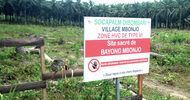
Land governance programme map
On January 22 a comprehensive database on land and resource governance programmes funded by members of the Global Donor Working Group on Land will be presented during the AGA in Paris.
// Global scope
// Main objectives of the database
// Visualisation and additional functions
The land governance programme database and map
Gregory Myers
Chief, Land Tenure and Property Rights Division, Bureau for Economic Growth, Education and Environment of USAID speaks about the upcoming land projects database which will contain information on location, duration, funding and scope of 445 "land" projects in 119 countries with a total value of 2.8 billion dollars — as well as on the specific aspects of the Voluntary Guidelines for the Responsible Governance of Tenure of Land, Fisheries, and Forests in the Context of National Food Security it supports.
Online, 16 Jan 2014. The overall aim of the comprehensive database on land and resource governance programmes is to improve donor coordination and to support implementation of the Voluntary Guidelines for the Responsible Governance of Tenure of Land, Fisheries, and Forests in the Context of National Food Security. To achieve this, a clear understanding of who is doing what and where in the land and resource governance sector is necessary. An interactive mapping tool clearly displays where different donors and development agencies are working and what they do. The database and map will be launched at the Platform AGA in Paris on the 22nd of January and will be hosted on the Platform website.
Secretariat: Greg, throughout 2013 USAID led an effort within the Global Donor Working Group on Land aiming to improve donor coordination and support to the Voluntary Guidelines of the FAO. You were also instrumental with the developing of the so-called donor database and map. It is going to come up and will be introduced very soon to the public at the Platform’s Annual General Assembly later this month in Paris. Greg, can you tell us a bit more about what this map is all about? And which kind of information will be accessible, what is the scope of this mapping exercise?
Gregory: Yes, Pascal, thank you very much. We recognise that to achieve greater coordination, we must first have a clear understanding of who is doing what and where in this sector. To that end USAID has been leading the effort to develop a comprehensive database of all land governance programs funded by members of the Global Donor Working Group on Land. So far we have collected information on approximately 600 programs in over 92 countries with a total value of about 2 billion dollars. The database contains information on the location, duration, funding and scope of each program. As well as information on what specific aspects of the Voluntary Guidelines are being supported by each program. The database also allows donors to include links to supplemental resources, such as reports on program websites and points of interest for each program. We also developed an interactive mapping tool that clearly displays where different donors and development agencies are working and what they are working on with respect to land and resource governance. This information can help us and other stakeholders better coordinate these programs and identify opportunities to leverage resources for greater impact in our efforts to improve food security and nutrition, reduce land related conflict and promote economic growth for women and men.
Secretariat: Greg, which donors have already fed their information into database? Can other donors still join the effort, the initiative?
Gregory: In addition to USAID and the Millennium Challenge Cooperation from the United States donor agencies from Austria, Belgium, Denmark, France, Germany, the Netherlands, Switzerland, Sweden, the United Kingdom as well as the European Union, the World Bank, have all contributed program information to the database. The Canadian and Japanese development agencies have also recently joined this initiative and are in the process of adding their program information to the database. The initiative is being conducted through the Global Donor Working Group on Land with the purpose of creating a comprehensive inventory of donor funded land programs. So at the moment only members of the Global Donor Working Group can contribute program information to the database. But we also see tremendous potential in linking the information in the donor database with other global and regional data sets being developed in land and resource governance, such as the African Union’s land policy initiative, the International Food Policy Research Institute’s mapping of land concessions, and another example is the 1st Peoples’ Indigenous Rights Risk Report, to just name a few. If we overlay the global donor database with these other data sets we can develop a more robust picture of where programs, issues and potential hot spots are located, as well as opportunities to align programs and investments to improve efficiency and priorities.
Secretariat: The map incorporates specific information on how each donor project supports the Voluntary Guidelines. Please explain how this tool supports the success of the Voluntary Guidelines at some point?
Gregory: The unanimous endorsement of the Voluntary Guidelines by 96 member countries of the Committee on World Food Security after a broad and inclusive constipated process which ended in 2012 was a major achievement that required tremendous effort by a wide range of stakeholders. But delivering on the promise of the Voluntary Guidelines is an even greater challenge for all of us, not just FAO. Delivering on this ambitious agenda will require coordinated action by development agencies, civil society organisations, governments and a private sector. The Global Donor Database which includes information on how each land governance project addresses specific aspects of the Voluntary Guidelines, provides a platform, if you will, for information sharing and coordination that can help stakeholders improve the effectiveness of the guidelines.
Secretariat: There have been mapping exercises in the past, we all know they all started well, but when it came to the time they were not maintained, they were outdated quite often. How will this database be kept up-to-date and maintained after the launch for this not to happen?
Gregory: Exactly. We hope at this time it will be different. As you know, the database is hosted by your organisation, the Global Donor Platform. And we are very grateful for the time and energy you have invested and working with us in making this initiative a reality and for your ongoing efforts to host and maintain the database and maps.
But ultimately as you say, a database is only as good as the information it contains. Each member of the Global Working Donor Group is responsible for managing and updating their own program information. The success of this initiative depends on members collective efforts to keep the information accurate and up-to-date. To facilitate this though, we developed the database as a decentralised system, so that each donor enters and manages their own program information directly. To start, members of the working group have committed to update their program information at least twice a year.
But, I would just like to add, because the database is decentralised, what that means is that you may have nine tenth of the members updating information and maybe one member is a bit slow to do that, the database will still be very useful.
Secretariat: Greg, you were one of the people pushing for the creation of the Global Donor Working Group on Land in 2013 and it was even mentioned now in the UK G8 Presidency Report. Why were you advocating so strongly for this group and where is the benefit of this group — especially in connection with the Global Donor Platform?
Gregory: As chair of the negotiations for the Voluntary Guidelines I take great pride in the importance of this global accomplishment. We believe the Voluntary Guidelines are a technical and political tool that can help producers both large and small to improve agricultural productivity and food security, expand economic growth and help lift millions of people out of poverty.
But we also know that the Voluntary Guidelines themselves are not enough. If we want to achieve our goals of broad based economical and sustainable growth, we must do more. We must redouble our efforts to fund programs that strengthen the land and resource governance, particularly for men and women. We have to help the private sector to better understand the risks and limitations of working in environments where there are weak land tenure systems. And we must work with responsible private sector companies to address these limitations and develop practical solutions that promote investment and respect property rights. The Global Donor Working Group can be an important voice for changing the way in which we conceptualise the role of property rights in achieving these and other important development objectives.
Let me close with an example about women’s property rights and economic empowerment. Women produce 43 percent of the food in developing countries but own less than ten percent of the land. In countries like Ethiopia closing the gender gap in agriculture would increase average crop yield 20 to 30 percent on women’s land. For this reason the United States was extremely pleased to enter into a partnership with the governments of Ethiopia, UK and Germany to improve land governance and enhance food security. This partnership which grew out of the coordinated efforts of the Global Donor Working Group will foster greater collaboration between Ethiopia and its development partners to support the Voluntary Guidelines and implement programs that improve in tenure security and economic empowerment for men and especially women. We believe this program is a model for this type of multi-stakeholder partnership in the future.
Secretariat: Thank you very much!













